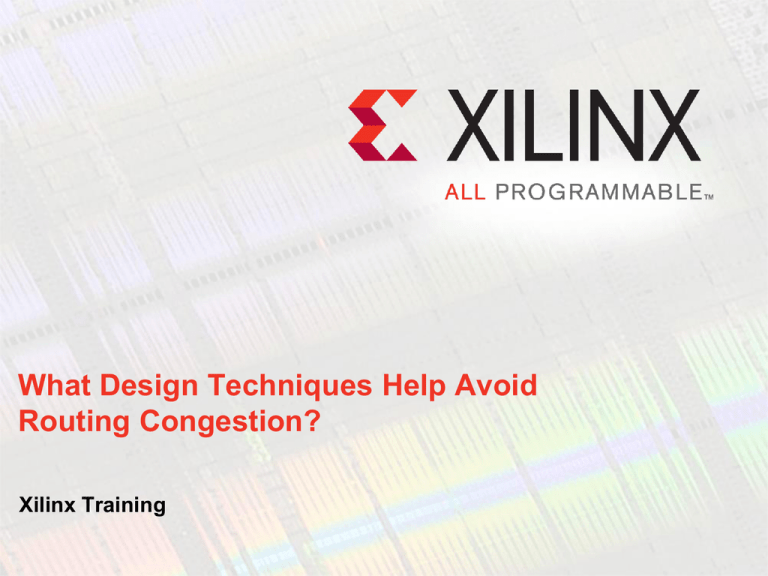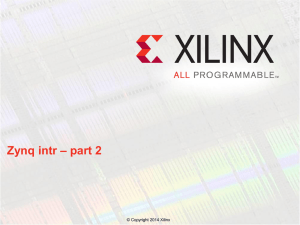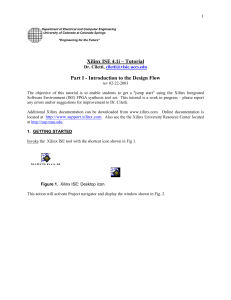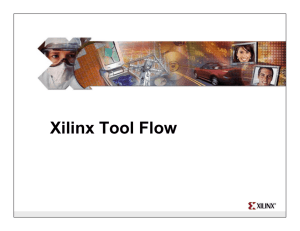
What Design Techniques Help Avoid
Routing Congestion?
Xilinx Training
Objectives
After completing this module, you will be able to:
Explain the causes of routing congestion problems
Use design techniques that optimize routing before a routing
congestion problem develops
Higher Bandwidth Applications
There is an increasing need for higher bandwidth and increased
device utilization in Virtex-6 applications
– Many applications require large amounts of data to be buffered to support
high bandwidths generated by the SerDes features
– This can create routing challenges and congestion that can impact timing
closure
– Not every design will be impacted, but it is better to build a better design
sooner, rather than later
Virtex-6 has three types of local routing resources
– Single, double, and quad which connect to one, two, and four CLBs away
– They have been optimized for performance and power
Designs with a high number of control signals or high-fanout
nets make routing more difficult
Routing Congestion Symptoms
The design fails to route with NO warnings in PAR that detail specific
nets that could not be routed
PAR issues this warning…
PAR Warning #464
The router has detected very dense, congested design. It is extremely unlikely the router will be able
to finish the design and meet your timing requirements. To prevent excessive run time the router will
change strategy. The router will now work to completely route this design but not to improve timing.
This behavior will allow you to use the Static Timing Report and FPGA Editor to isolate the paths
with
timing problems. The cause of this behavior is either overly difficult constraints, or issue with the
implementation of synthesis of logic in the critical timing path. If you are willing to accept a long run
time, set the option “-xe c” to override the present behavior.
Routing Congestion Symptoms
Another symptom is a series of “intermediate status” stages
reported by PAR
intermediate status: 10600 unrouted: Real time: 3 hrs 11 mins 59 secs
intermediate status: 10719 unrouted: Real time: 3 hrs 41 mins 51 secs
intermediate status: 10743 unrouted: Real time: 4 hrs 11 mins 47 secs
intermediate status: 10691 unrouted: Real time: 4 hrs 11 mins 44 secs
Reduce Sets, Resets, and CEs
Routing can be considered one of the most valuable
resources
Secondary Control Signals compete for the same
resources as the rest of the active signals of the
design
Including timing-critical paths
More available routing gives the tools a better chance to
meet your timing objectives
Tip: Using the
GSR saves
routing resources
Global Reset Net
The GSR input is an active-high global set/reset
net that is active at the end of configuration
– It uses a dedicated routing resource for signal
distribution
• Saves general interconnect
– It can also be used to restore the initial state of the
FFs in the FPGA at any time (although not
recommended)
• The initial state is communicated with an INIT attribute
• It drives the output FFs for each block RAM, but does not
affect the contents of each memory or SRL
• Its routing delay is NOT characterized
– It is connected to all synchronous elements through a
wired OR gate
• This allows a local reset to also drive the FF’s set/reset
port
Getting By
Some designs can get away without any resets but many
designs need some resets
– Very few designs require resets on all registers, but most designers
want a global reset after initialization
• Most ASIC emulation also requires a described reset on every register.
• Implement this global reset with the built-in Global Set/Reset (GSR)
GSR is good for initializing the values of your synchronous elements
(FFs, Block RAMs)
Delay of GSR is slow (3 clock cycles after configuration) so use it
after configuration, but don’t reset again unless you can tolerate the
entire design being reset
Inferring an Initialization (XST only)
If you have a reset, you can initialize all registers in VHDL /
Verilog code
SR will cause the flip-flop to be set to the state inferred here
– Inference is supported only for data types std_logic, bit_vector, bit, but
NOT integer
VHDL:
signal my_regsiter : std_logic_vector (7 downto 0) := (others <= ‘0’);
Verilog:
reg [7:0] my_register = 8’h00;
This is helpful for RTL simulation of the design
– If it functions during simulation, it should function on the FPGA
– Note…if you design without a reset in your design, you still get a free
global reset
Minimizing the Use of DCMs or PLLs
Case A – Embedded DCM
Case B – External DCM
DCM or PLL
In-1
In-1
Logic and Flip-flops
DCM
In-x
In-x
• DCMs are a limited
resource
• Using fewer DCMs saves
global clock buffers
Pulling buried DCMs or PLLs up to the top level
reduces the resources the clocking resources your
design will use
Global Clock Enable
To gate entire clock domains for power reduction, use the
clock-enabled global buffer resource BUGCE or the BUFHCE
– For applications that only pause the clock on small areas of the
design, use the clock enable pin of the FPGA register
– This saves general routing resources
Tip: This will save routing resources
Page 11
Summary
Designs with a high number of control signals or high-fanout
nets make routing more difficult
Pulling buried DCMs or PLLs up to the top level
Use the GSR on power-up to reset your circuit into a known state
– The GSR is used after configuration, every time
– Don’t use it to reset the circuit during normal operation
– Build your HDL code properly to infer an initialization value
Use the built-in CE features of the BUFHCE and the BUFGCE
Where Can I Learn More?
Xilinx online documents
– www.support.xilinx.com
• PlanAhead User Guide, UG632
Display design metrics
• Floorplanning Methodology Guide, UG633
How to re-use placement information (Re-use Flow)
• Retargeting Guidelines for Virtex-5 FPGAs, WP248
Helpful resource to clarify HDL coding techniques
• Command Line Tool User Guide, UG628
How to run SmartXplorer with congestion reduction
strategies
Where Can I Learn More?
Xilinx Education Services courses www.xilinx.com/training
– Designing with Spartan-6 and Virtex-6 Device Families course
• How to get the most out of both device families
• How to build the best HDL code for your FPGA design
• How to optimize your design for Spartan-6 and/or Virtex-6
• How to take advantage of the newest device features
Free Video-based Training
– How To Create Area Constraints with PlanAhead
– What are the Benefits of PlanAhead?
– How do I Resolve Routing Congestion?
Trademark Information
Xilinx is disclosing this Document and Intellectual Property (hereinafter “the Design”) to you for use in the development of designs to operate on,
or interface with Xilinx FPGAs. Except as stated herein, none of the Design may be copied, reproduced, distributed, republished, downloaded,
displayed, posted, or transmitted in any form or by any means including, but not limited to, electronic, mechanical, photocopying, recording, or
otherwise, without the prior written consent of Xilinx. Any unauthorized use of the Design may violate copyright laws, trademark laws, the laws of
privacy and publicity, and communications regulations and statutes.
Xilinx does not assume any liability arising out of the application or use of the Design; nor does Xilinx convey any license under its patents,
copyrights, or any rights of others. You are responsible for obtaining any rights you may require for your use or implementation of the Design.
Xilinx reserves the right to make changes, at any time, to the Design as deemed desirable in the sole discretion of Xilinx. Xilinx assumes no
obligation to correct any errors contained herein or to advise you of any correction if such be made. Xilinx will not assume any liability for the
accuracy or correctness of any engineering or technical support or assistance provided to you in connection with the Design.
THE DESIGN IS PROVIDED “AS IS" WITH ALL FAULTS, AND THE ENTIRE RISK AS TO ITS FUNCTION AND IMPLEMENTATION IS WITH
YOU. YOU ACKNOWLEDGE AND AGREE THAT YOU HAVE NOT RELIED ON ANY ORAL OR WRITTEN INFORMATION OR ADVICE,
WHETHER GIVEN BY XILINX, OR ITS AGENTS OR EMPLOYEES. XILINX MAKES NO OTHER WARRANTIES, WHETHER EXPRESS,
IMPLIED, OR STATUTORY, REGARDING THE DESIGN, INCLUDING ANY WARRANTIES OF MERCHANTABILITY, FITNESS FOR A
PARTICULAR PURPOSE, TITLE, AND NONINFRINGEMENT OF THIRD-PARTY RIGHTS.
IN NO EVENT WILL XILINX BE LIABLE FOR ANY CONSEQUENTIAL, INDIRECT, EXEMPLARY, SPECIAL, OR INCIDENTAL DAMAGES,
INCLUDING ANY LOST DATA AND LOST PROFITS, ARISING FROM OR RELATING TO YOUR USE OF THE DESIGN, EVEN IF YOU HAVE
BEEN ADVISED OF THE POSSIBILITY OF SUCH DAMAGES. THE TOTAL CUMULATIVE LIABILITY OF XILINX IN CONNECTION WITH
YOUR USE OF THE DESIGN, WHETHER IN CONTRACT OR TORT OR OTHERWISE, WILL IN NO EVENT EXCEED THE AMOUNT OF
FEES PAID BY YOU TO XILINX HEREUNDER FOR USE OF THE DESIGN. YOU ACKNOWLEDGE THAT THE FEES, IF ANY, REFLECT
THE ALLOCATION OF RISK SET FORTH IN THIS AGREEMENT AND THAT XILINX WOULD NOT MAKE AVAILABLE THE DESIGN TO YOU
WITHOUT THESE LIMITATIONS OF LIABILITY.
The Design is not designed or intended for use in the development of on-line control equipment in hazardous environments requiring fail-safe
controls, such as in the operation of nuclear facilities, aircraft navigation or communications systems, air traffic control, life support, or weapons
systems (“High-Risk Applications”). Xilinx specifically disclaims any express or implied warranties of fitness for such High-Risk Applications. You
represent that use of the Design in such High-Risk Applications is fully at your risk.
© 2012 Xilinx, Inc. All rights reserved. XILINX, the Xilinx logo, and other designated brands included herein are trademarks of Xilinx, Inc. All
other trademarks are the property of their respective owners.







